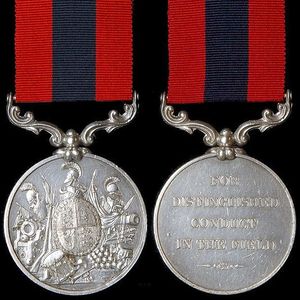Difference between revisions of "Distinguished Conduct Medal"
From Our Contribution
| (8 intermediate revisions by the same user not shown) | |||
| Line 2: | Line 2: | ||
==Eligibility== | ==Eligibility== | ||
| − | The award was instituted on 4th December 1854. | + | The award was instituted on 4th December 1854 for other ranks during the Crimean War. Discontinued in 1993. |
All Officers were able to cite or recommend men for recognition based on their actions in the field. In addition to the nominating Officer there should be three witness supporting the nomination. | All Officers were able to cite or recommend men for recognition based on their actions in the field. In addition to the nominating Officer there should be three witness supporting the nomination. | ||
| Line 21: | Line 21: | ||
During WW1 24,591 awards were made, with 472 being awarded a Bar, and nine who were awarded it three times. | During WW1 24,591 awards were made, with 472 being awarded a Bar, and nine who were awarded it three times. | ||
| − | ==Awarded to:== | + | |
| + | ==Awarded to the following locals:== | ||
| + | *[[Ernest Ball DCM]] | ||
| + | *[[George Chistopher Dalziell DCM]] | ||
| + | *[[John Edwin Ffoulkes DCM]] | ||
*[[William Clarence Martin DCM & Bar]] | *[[William Clarence Martin DCM & Bar]] | ||
| + | *[[Henry Ivor Passmore DCM]] | ||
| + | *[[Lawrence Adrian Renou DCM]] | ||
==Post WW1 Men== | ==Post WW1 Men== | ||
| − | *[[Spencer Gwynne DCM | + | *[[Spencer Gwynne DCM MID]] |
<references /> | <references /> | ||
Latest revision as of 01:27, 4 October 2018
Contents
Eligibility
The award was instituted on 4th December 1854 for other ranks during the Crimean War. Discontinued in 1993.
All Officers were able to cite or recommend men for recognition based on their actions in the field. In addition to the nominating Officer there should be three witness supporting the nomination.
A citation is a brief report providing details of the deed for which an award for gallantry has been granted to an individual.
A recommendation for a gallantry award was usually given by a commanding officer. When the award was granted these details were generally used to create the citation for the award. Unfortunately almost all the recommendation forms W3121 from the First World War were destroyed in enemy bombing in the Second World War.
The award of a gallantry or distinguished service medal and a Mention in Despatches was published in The London Gazette.
The D.C.M. was the first official medal award to recognise an act of gallantry in the field by a member of the armed forces who was below the rank of officer. It was the other ranks' equivalent of the Distinguished Service Order. Modern day Australian equivalent would be the Star of Gallantry.
During the First World War, the concern arose that the overwhelming number of medals which were being awarded would devalue the prestige of those already awarded. The Military Medal for bravery in battle on land was therefore instituted on 25 March 1916, as an alternative award to the Distinguished Conduct Medal. The lesser Military Medal was usually awarded for bravery from this date and the Distinguished Conduct Medal was reserved for exceptional acts of bravery.
Description
The reverse of the medal bears the inscription “For Distinguished Conduct in the Field”. A bar carrying the date of a subsequent deed could be added to the ribbon until 1916 when the bar was changed to a laurel wreath. A recipient of the award is entitled to used the letters D.C.M. after their name.
During WW1 24,591 awards were made, with 472 being awarded a Bar, and nine who were awarded it three times.
Awarded to the following locals:
- Ernest Ball DCM
- George Chistopher Dalziell DCM
- John Edwin Ffoulkes DCM
- William Clarence Martin DCM & Bar
- Henry Ivor Passmore DCM
- Lawrence Adrian Renou DCM
Post WW1 Men
